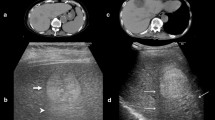Summary
The effects of hepatic artery administration of degradable starch microspheres on liver energy charge and nucleic acid anabolism were studied in rats.
Liver energy charge was evaluated 20 and 60 min after the injection of degradable starch microspheres. As compared to controls the microspheres had no effect on liver energy charge.
The incorporation of orotic acid, uracil, and thymidine into liver RNA or DNA was studied 1 h after hepatic artery injection of precursor alone or together with degradable starch microspheres. Orotic acid and uracil incorporation into RNA was studied in normal rats and the DNA incorporation of thymidine in animals with regenerating livers. Orotic acid and thymidine were given in trace amounts. Uracil was given in amounts corresponding to a therapeutic dose of 5-fluorouracil. The addition of microspheres had no effects on the incorporation of the nucleic acid precursors into RNA or DNA.
Thus, in the normal liver degradable starch microspheres administered by the hepatic artery had no influence on liver energy charge or RNA anabolism in the liver. Also the microspheres had no negative effects on the DNA anabolism in proliferating liver cells.
Similar content being viewed by others
References
Arfors K-E, Forsberg JO, Larsson B, Lewis DH, Rosengren B, Ödman S (1976) Temporary intestinal hypoxia induced by degradable microspheres. Nature 262:500–501
Rothman U, Arfors K-E, Aronsen KF, Lindell B, Nylander G (1976) Enzymatically degradable microspheres for experimental and clinical use. Microvasc Res 11:421
Arfors K-E, Tuma RF, Ågerup B (1979) Biospheres—a tool to induce transient ischemia in experimental medicine as studied in the kidney. Bibl Anat 18:204–206
Lindell B, Aronsen KF, Nosslin B, Rothman U (1978) Studies in pharmacokinetics and tolerance of substances temporarily retained in the liver by microsphere embolization. Ann Surg 187:95–99
Aronsen KF, Hellekant C, Holmberg J, Rothman U, Teder H (1979) Controlled blocking of hepatic artery flow with enzymatically degradable microspheres combined with oncolytic drugs. Eur Surg Res 11:99–106
Teder H, Aronsen KF, Lindell B, Rothman U (1978) Studies in pharmacokinetics of 5-fluorouracil temporarily retained in the rat liver by degradable microsphere embolization. Acta Chir Scand [Suppl 487] 144:71
Tuma RF, Forsberg JO, Ågerup B (1982) Enhanced uptake of Actinomycin D in the dog kidney by simultaneous injection of degradable starch microspheres into renal artery. Cancer 50:1–5
Christensson P, Eriksson G (1985) Effects of six anaesthetic agents on UDP-glucuronic acid and other nucleotides in rat liver. Acta Anaesthesiol Scand (in press)
Leivestad OE, Malt R (1973) Continuous infusion into the hepatic artery and vena cava of the rat. Surgery 74:401–404
Lewan L, Amneus H, Forsberg O, Lundberg K (1983) Intra-arterial and intraportal in vivo catheterization of the regenerating rat liver: Effects upon body and liver weights and DNA synthesis. Upsala J Med Sci 88:33–41
Higgins G, Anderson R (1931) Experimental pathology of the liver. I. Restoration of the liver of the white rat following partial surgical removal. Arch Pathol 12:186–202
Bergman G, Husberg B (1980) A method for multiple intra-arterial injections in the allogenic or isogenic transplantated rat kidney by use of a long-term catheter in the renal artery. Scand J Urol Nephrol [Suppl] 54:116–119
Zimmerman HM, Bank S, Smolow C, Burns G, Lendvai S (1983) Comparison of electrophoretic isoamylase patterns among various species. Am J Gastroenterol 78:575–578
Teder H, Nilsson M, Aronsen KF (1985) Gamma camera evaluation of the effects of degradable starch microspheres on arterial liver blood flow in the rat. Res Exp Med (in press)
Eriksson G (1984) Isotachophoretic determination of the base composition in rat liver RNA with and without a column coupling system adapted to a tachophor capillary. In: Holloway CJ (ed) Analytical and preparative isotachophoresis. Walter de Gruyter, Berlin New York, pp 145–152
Munro H, Fleck A (1966) Recent developments in the measurement of nucleic acids in biological material. Analyst 91:78–88
Burton K (1956) A study of the conditions and mechanisms of the diphenylamine reaction for the colorimetric estimation of DNA. Biochem J 62:315–323
Scott JE, Fraccastoro AP, Taft EB (1956) Studies in histochemistry. I. Determination of nucleic acids in microgram amounts of tissue. J Histochem Cytochem 4:1–10
Hinrichs R, Petersen R, Baserga R (1964) Incorporation of thymidine into DNA of mouse organs. Arch Pathol 48:245–253
Atkinson DE (1968) The energy charge of the adenylate pool as a regulatory parameter. Interaction with feedback modifiers. Biochemistry 7:4030–4034
Cleaver JE (1967) Thymidine metabolism and cell kinetics. Front Biol 6:43–53
Mandel HG (1981) The target cell determinants of the antitumour actions of 5-FU: Does FU incorporation into RNA play a role? Cancer Treat Rep [Suppl 3] 65:67–71
Bucher N, Swaffield M (1964) The rate of incorporation of labelled thymidine into the DNA of regenerating rat liver in relation to the amount of liver excised. Cancer Res 24:1611–1625
Chang LO, Looney WB (1965) A biochemical and autoradiographic study of the in vivo utilization of tritiated thymidine in regenerating rat liver. Cancer Res 25:1817–1822
Ord M, Stocken LA (1973) Uptake of orotate and thymidine by normal and regenerating rat livers. Biochem J 132:47–54
Breedis C, Young G (1954) Blood supply of neoplasms in the liver. Am J Pathol 30:969–985
Ackerman NB, Lien WM, Kondi ES, Silverman NA (1969) The blood supply of experimental liver metastases. I. The distribution of hepatic artery and portal vein blood to “small” and “large” tumor. Surgery 66:1067–1072
Mukherjee KL, Boohar J, Wentland D, Ansfield FJ, Heidelberger C (1963) Studies on fluorinated pyrimidines. XVI. Metabolism of 5-fluorouracil-2-14C and 5-fluoro-2′-deoxyuridine-2-14C in cancer patients. Cancer Res 23:49–77
Author information
Authors and Affiliations
Additional information
Sponsored by grants from the Cancer Research Foundation at Malmö General Hospital and the Royal Physiographic Society
Rights and permissions
About this article
Cite this article
Teder, H., Christensson, P.I., Aronsen, K.F. et al. Hepatic artery administration of degradable starch microspheres. Res. Exp. Med. 185, 405–414 (1985). https://doi.org/10.1007/BF01851921
Received:
Accepted:
Issue Date:
DOI: https://doi.org/10.1007/BF01851921




